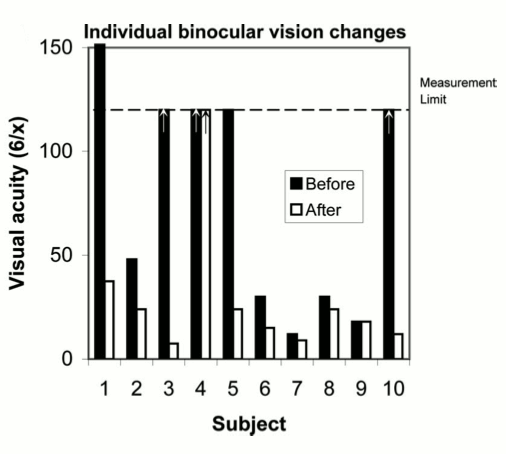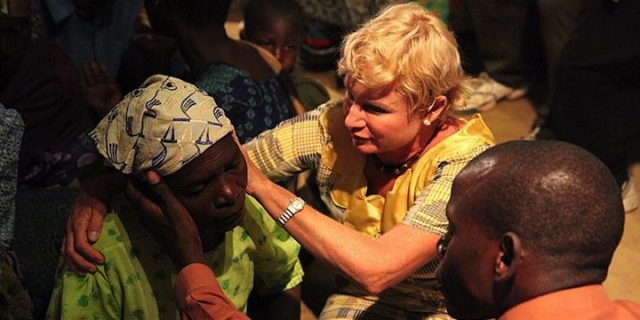This page in brief ….
A professor investigates the effectiveness of prayer for healing as part of her academic work. She travels to Mozambique to test people seeking healing of sight and hearing – the tests are conducted immediately before and after the prayer.
The results are convincing and statistically significant – people’s sight and hearing were significantly restored.
Candy Gunther Brown
Candy is Professor of Religious Studies at Indiana University, a historian with a PhD from Harvard. She has researched various aspects of religion in America, including the effectiveness of prayer for healing.
As part of her research into healing, she has examined ways to best test the results of healing prayer, and the used some of these methods in a study of people seeking healing in Mozambique. She visited Mozambique herself to do the tests.
How to study intercessary prayer
Candy observes that most research on intercessary prayer studies “distant prayer” – prayer where the person praying and the person being prayed for are not known to each other and never meet. This allows “double blind” experiments where the patients don’t know if they are being prayed for or not.
But, she argues, most healing prayer is conducted face-to-face and hands-on, so such experiments don’t really test the type of prayer commonly received by sick people.
Studying prayer as it is actually prayed
So she suggests “proximal intercessory prayer” (PIP) should be studied, and argues that four different approaches should be combined to give a comprehensive overall picture:
- Compare medical records before and after prayer.
- Survey how sufferers feel about the effectivenerss of healing prayer.
- Conduct clinical trials and measure selected health markers of the patients.
- Follow up patients some years later to see if the effects of prayer are lasting.
One difficulty with her approach is that it is difficult to see how a “no treatment” control group can be set up – how can someone be offered “sham prayer”, and how could she ethically do this to someone seeking healing? (It seems to me many medical studies face this kind of ethical dilemma.)
She points out that this science cannot prove, or disprove, that a supernatural power has healed someone. It is only a preliminary study, aimed at establishing if there is an outcome that deserves further investigation, but it can show if the practice of prayer makes a measureable difference to health.
Some results from the four approaches
1. She has reviewed medical records and found many cases where the evidence shows the patient experienced an unusual recovery (somewhat similar to this study) – and some cases of fraud or misreporting.
2. Surveys she conducted showed that those suffering from illness are very pragmatic, utilising both medicine and prayer. Many reported being healed, often gradually over many prayers.
3. She conducted a small study in Moxambique – discussed below.
4. Many informants report remaining healed several years after the event. The success of prayer has led them to encourage others to seek prayer also.
Healing in Mozambique
Professor Brown travelled to Mozambique to observe healings and test people seeking healing at an actual healing event. Patients seeking healing for eyesight and/or hearing were selected because measuring sight and hearing require only simple tests. 24 consecutive patients seeking these forms of healing were selected, and their eyesight and hearing (as appropriate) were measured immediately before and after prayer.
This is only a small sample, which makes it harder statistically to show a significant result. Nevertheless, a statistically significant result was found in each case.
The results
Her results were published in the Southern Medical Journal in 2010. The study found there was a highly significant improvement in hearing
across the 18 ears tested, and significant visual improvements
for those whose eyes were prayed for.
These statistically significant improvements were much greater than the improvement several other studies found as a result of hypnosis or suggestion.

Vision improvements – lower values are better.
Two examples
One subject, Jordan, was presented as deaf and mute since birth and made no responses to sounds at 100 dBHL; after PIP, he responded to 60 dBHL tones, imitating sounds in a hoarse, raspy voice.
Before prayer, Maryam could not count fingers from one foot away; after one minute of PIP, she was reading the 20/125 line on a vision chart.
Weaknesses in the study
As already noted, the study was far from ideal, especially in not having any control group. However this was partly overcome by comparing the results to the results of other studies where suggestion was the only “treatment”, which showed that prayer was much more effective than suggestion, at least for the groups studied.
A second problem relates to the fact that hearing and eyesight were measured using the patients’ responses to an audiometer and eyechart. Thus it is likely there was some subjectivity in the results, for example, the patients may have been more familiar with the equipment the second time around and so obtained better results. However the paper suggests that similar effects would have occurred in the studies of hypnosis and suggestion, so the much more significant results of this prayer study are clear.
Prayer is a very personal matter, and all experiments are going to have weaknesses. Some studies utilise more rigorous methods, but at the cost of testing situations divorced from real life. Brown’s approach tests real life situations, but with a loss of rigour.
As Brown suggests, it is best to utilise a number of different methods. So the results of this study must be placed against the results of other studies. But these results are impressive.
Conclusion
Candy Brown makes no mention in the paper of whether God could be considered to have healed these patients, but recommends that prayer be further assessed as a useful adjunct to standard medical care for certain patients with auditory and/or visual impairments, especially in contexts where access to conventional treatment is limited.
For poor people in rural Mozambique, prayer may be their only hope of improved eyesight and hearing. Who can blame them for seeking healing? And who cannot feel pleased that they are obtaining significant improvement?
And why would anyone suffering any form of illness not consider asking for prayer?
Healing and God
The evidence is slowly accumulating. Prayer for healing doesn’t always lead to the improvement sought – in fact it often doesn’t. But there are sufficient indications, using several different types of testing and observation, that many people are healed after they receive prayer. Perhaps the outcomes were coincidental, but I find it hard to think so.
Read more
- Healing miracles and God – a summary, on this site.
- Study of the Therapeutic Effects of Proximal
Intercessory Prayer (STEPP) on Auditory and Visual Impairments in Rural Mozambique by Brown et al, 2010. - Articles by Candy Gunther Brown: Testing Prayer: Can Science Prove the Healing Power of Prayer? and What Counts as Legitimate Scientific Research on Prayer? in Huffington Post, and Clinical Trials: Can health outcomes of prayer be measured? in Psychology Today.
- A truly dreadful study into the effects of prayer – a critical review in Secular News Daily.
- Candy Gunther Brown’s CV.
Picture: Heidi Baker praying for healing in Mozambique, courtesy of Iris Global.
Feedback on this page
Comment on this topic or leave a note on the Guest book to let me know you’ve visited.




